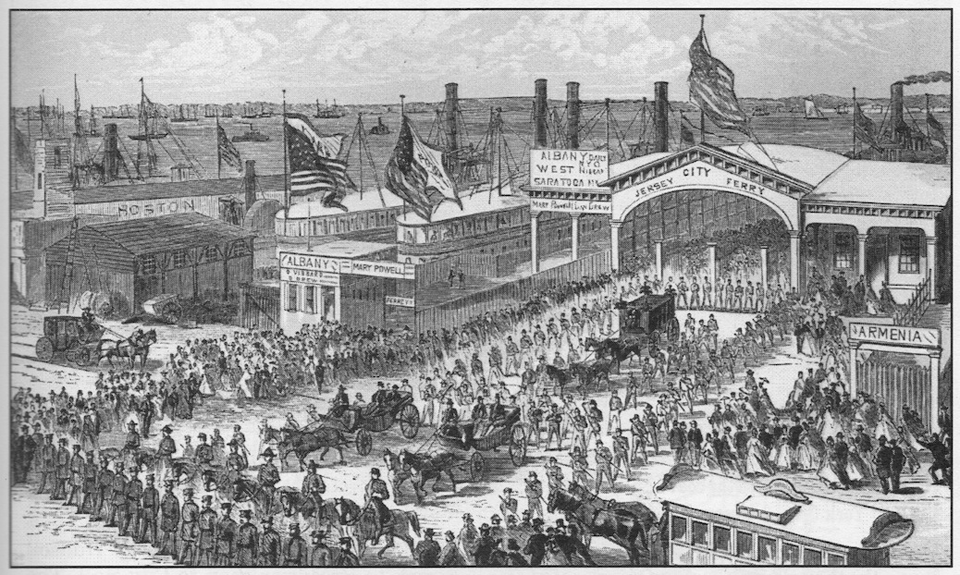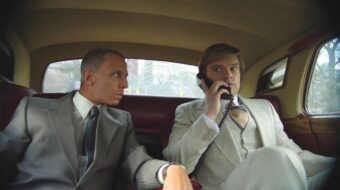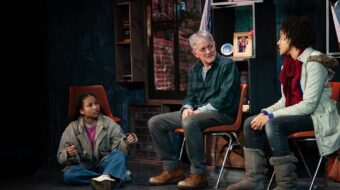
We last encountered the forward-looking choral group called “The Crossing,” conducted by Donald Nally, in Julia Wolfe’s sweatshop piece Fire in My Mouth, about the Triangle Shirtwaist Fire.
The group’s latest release is Anonymous Man, a 58-minute work for a chorus of 24 singers, a cappella so far as I could hear, although in the CD program booklet John Grecia is credited on keyboards (maybe just for rehearsal or tuning?). This new choral work premiered in 2017 and was recorded in 2018. The composer is Michael Gordon (no relation), a well regarded, frequently performed composer on the New York City new music scene, and now often commissioned for musical ensembles worldwide.
Curiously, the text of the nine-part composition, like the Wolfe piece, also comments about the happenings on a New York City street not far away from the infamous 1911 fire off of Washington Square. Both the words and the music are by Gordon. Although there is much that is autobiographical about Anonymous Man, it aims at a higher level of universality. The first movement, the brief “A Tale,” summons up Charles Dickens’s novel A Tale of Two Cities, in its physical and historical reach. “This is a tale of two,” Gordon writes, “One lives inside / The other one outside.” It is a story about social class, romance, the enduring power of literature, the burden of history’s unfulfilled promises, and a derelict industrial neighborhood in Lower Manhattan that in time would become gentrified.
Welcome to Desbrosses Street. It’s pronounced in three syllables: De-bross-es, although some sources say Des-bross-es.
“When I moved into my loft on Desbrosses,” Gordon writes in a prefatory note, “the streets were empty, since few people lived there. But both then and now, they were the homeless. Over time the neighborhood changed from an industrial warehouse district to a residential area. Anonymous Man is a memoir about my block. The piece is built around my memories of moving in, meeting my future wife for the first time there, and conversations I have had with two homeless men who made their home on the loading dock across the street.”
Already we pick up certain dissonances. Is this tale really about two people, as the first movement announces? For we are introduced to the composer, his wife, and two homeless men, Robinson and Larry—that’s four. But we also meet others, such as the landlord, a band Gordon played with called “Peter and the Girlfriends,” a professor from Mississippi who gave Gordon a furniture store job, the couple’s two children, passersby named Eve, Mitchell and Jordi, and there’s even a flashback cameo appearance of Abraham Lincoln’s hearse, when in 1865 his funeral cortege arrived in Manhattan via the Desbrosses Street Ferry from Jersey City.
I interpret this composition, then, to be not about two individuals, but about two classes of people: Those with enough wherewithal to reside indoors, with a roof overhead, and those who are forced by economic circumstance and the multiple failures of society, to live outdoors, amidst the elements.
The music of the first movement sets the tone and timbre of the whole piece. The actual words are difficult to distinguish in the high-pitched women’s voices that open, sounding like a chorus of cooing pigeons echoing through the vastness of an empty cathedral, or ricocheting through the empty streets Gordon describes. At first I thought the text quoted above was just a summary of the movement, as I thought I kept hearing the Latin word “Pacem” (peace), but I was probably mistaken. The men enter after a while establishing what will become the common system of the entire work, contrasting women’s and men’s voices in strongly opposing counterpoint. Not often do we hear the men’s and women’s voices singing together, but it is pleasing when we do.
The second movement recounts the composer’s introduction to the building, which had once housed the Romanoff Caviar Company, thus establishing the working-class character of these once-industrial sites now worth millions in New York’s overheated real estate market. Interestingly, it’s the women who begin relating Gordon’s first-person story, the male voices providing for long stretches a low carpet of thrumming sound that suggests the place might also at one time have held hundreds of sewing machines. He starts describing his “tale of twos”: “Outside the streets were dark and desolate. The windows rattled from the cold and rain.”
Gordon deploys his singers not in standard blocks of sopranos, altos, tenors and basses, but in multi-layered harmonies like a chorus of soloists. He finds tantalizing rhythms in the most prosaic of sentences that on the printed page one would not easily associate with suitable choral texts. Just one out of many examples that could be quoted, as he sets out to remodel the space as his living quarters: “I bought the Readers Digest Complete Do It Yourself Manual, which had a lot of practical information on building walls and things like that.” This is Bauhaus, stripped to the walls music.
In the third movement we meet Larry, one of the “people living on the street.” Again the women introduce the text, and the men pick up their riff in a fugal pattern, as if to multiply and amplify the homelessness of one into many. Larry was “quiet and sweet, muttering, waving.”
In movement four Gordon meets his future wife Julie. They go out to Leroy’s Coffee Shop on West Broadway at Sixth Avenue (always Sixth Avenue to born New Yorkers, but to newcomers and to the post office known as Avenue of the Americas). It’s a filmic “meet cute” encounter that, to my surprise, mentions my hometown New Haven. “Come back to Desbrosses Street,” the text of this movement concludes, “and marry me, it will be happy endings,” but the chorus continues singing unintelligibly for a little while longer, perhaps suggesting some “happy endings” better not put into words. As it turns out, though not noted as such in the CD booklet, the “Julie” he marries is none other than his fellow composer Julia Wolfe.
“I First Noticed Robinson” is section five, describing a man surrounded by his belongings. On most days Robinson could be seen reading a broad range of books “in English and French, history and philosophy.” One day Gordon found him “reading the complete plays of Aristophanes.” This movement is unlike all the others insofar as it is accompanied by a rhythmic beating as if by a drumstick on a wooden surface, and as much as, or more than in any other movement, Gordon puts his chorus in a kind of modern Gregorian chant mode.
By the end of the movement Gordon “noticed that Robinson was a little uneasy. ‘The scaffolding’s down and I will be moving.’ After years of renovation the building across the street was finished. And with the increase in foot traffic, the doormen and the new residential tenants, the street offers less protection. The street offers less obscurity. The street offers less anonymity.” One more homeless person is driven away and will never be seen on Desbrosses Street again. But who was he? Gordon clearly depicts him as someone with education, intelligence, dignity. Couldn’t the richest city in the richest country in the world have found a comfortable home with a roof overhead—not just for Robinson but for everyone? The word “capitalism” doesn’t even have to be uttered: It’s implicit in every breath.
Gordon tries a welcome new musical effect in “On That Terrible Beautiful Morning”—and no, this is not Oklahoma, it’s New York City on September 11, 2001. As he describes the ordinariness of that bright late-summer day that dawned on Lower Manhattan, the chorus sings in big waves up and down the scale, as if possessed by a dizzying frenzy. It’s perhaps the most emotionally expressive movement of the work, which otherwise has a kind of minimalist blandness to it, a musical palette with little interest in picturesque word-painting. One can see in those vocal waves the gaze of New Yorkers shifting from up toward the skyscrapers to down below where the streets would soon be filled with ash and debris. Now businesses that were housed in the World Trade Center will also be, at least temporarily, homeless. “[E]verything ran in slow motion. Eerie hushed chaos enveloped the streets, smoke and flames pouring out above us.”
“One day I saw a make-shift memorial where Larry lived. The alcove he slept in was covered with flowers and candles.” The Downtown Express, the local paper of record, reported the neighbors’ mourning of this kindly, familiar man, quoting memories of him by Eve, Mitchell and Jordi. Gordon’s little requiem for this poor, homeless man reclaims his immanence for all time, not just as a passing Tribeca street character in this intimate choral portrait of a quiet New York City neighborhood, but as a symbol of all those anonymous souls who are the disposable wretched refuse of an unwelcoming city.
One of the few instances of obvious word-painting occurs in section eight about Abraham Lincoln. The scene Gordon depicts, relying on contemporary iconography of the event, reminds listeners of the history of his adopted street, and puts into sharper relief the problems remaining in American society that the Civil War never even came close to resolving. Gordon speaks of various places where the funeral train passed, where “bells tolled, minute guns fired.” I didn’t hear any gunshots, but on the word “bells” the chorus demonstrably imitated the somber metallic sounds. I wonder if the composer was familiar with a longer cantata on the subject, The Lonesome Train by Earl Robinson, which was played repeatedly on the radio in the days following FDR’s death in 1945.
“I Sleep At Home” ends the work. Of course we understand this to be Gordon’s own tale, but the only person referred to is the otherwise unidentified “I” of the movement title. The text consists of eight lines of plain words: “I sleep at home. I have a bed. / I put my head on a pillow. / I have a door. I have a closet. / My clothes are clean and folded. / I have a chair. I can sit down. / There is a light. I can turn it on. / I have a roof. There is a window. / When it is raining I am dry. / When it is thundering I am wondering.”
“Wondering” is the last word of the work. What is he wondering about, this “I” inside? How “the other one outside” is faring, no doubt. The one—the many ones—who simply cannot take for granted any of those decent, ordinary things he mentions, which most people who have certainly don’t feel they are especially privileged to enjoy. And that is the “tale of two.” The best of times for one; the worst of times for the other.
Perhaps the next time we see people living on the street they won’t appear so anonymous.
A wealth of further information about the composer can be found here.
Anonymous Man
Words and music by Michael Gordon
The Crossing, conducted by Donald Nally
Cantaloupe Music CA 21154












Comments